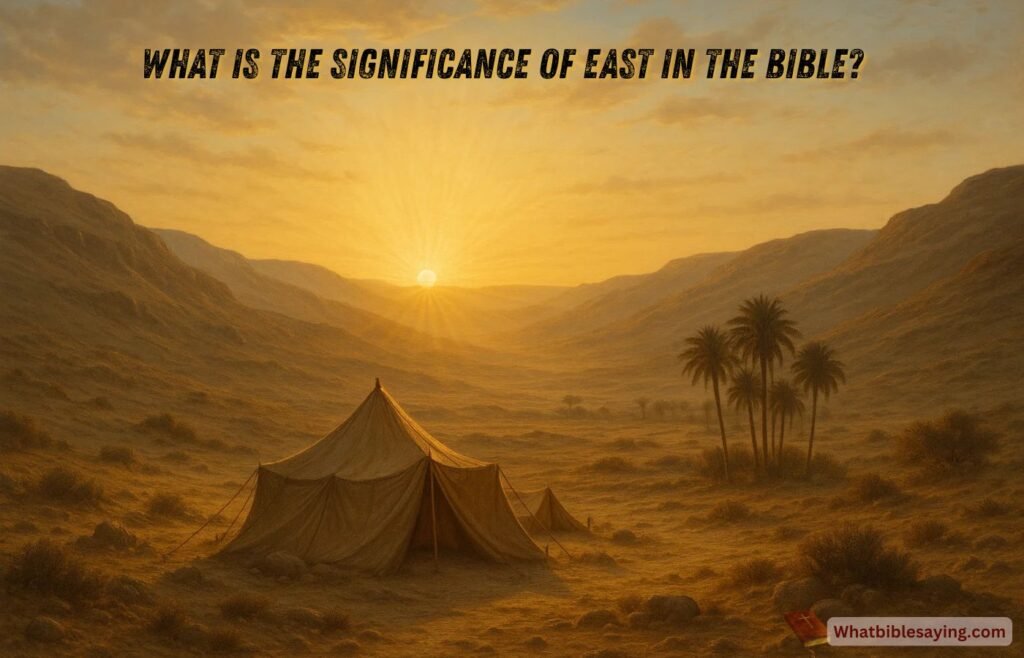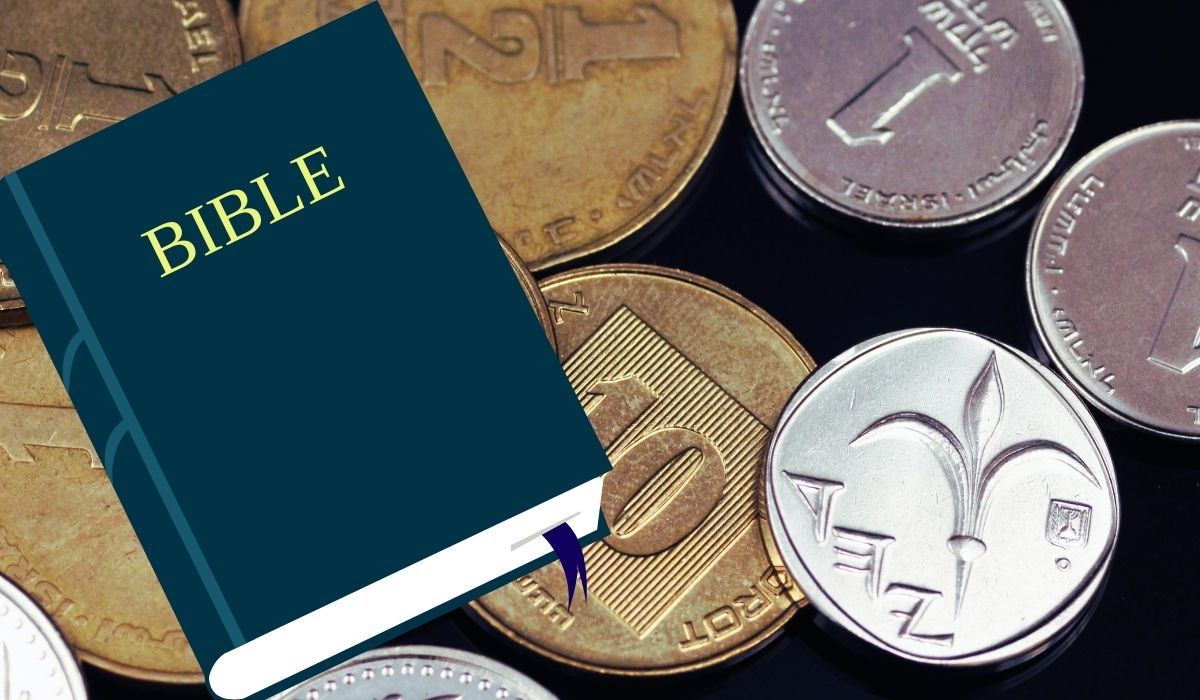Introduction: Why Look to the East?
When you open your Bible and notice how often the direction east appears, you begin to wonder: Why is east important in the Bible? From the Garden of Eden to the return of Christ, the east carries a unique weight in Scripture. It’s not just a compass point, it’s a doorway to understanding God’s story of creation, judgment, renewal, and hope.
In this article, we will walk together through the Bible, exploring how the east is used, what it symbolizes, and why it matters for your faith today. We’ll look at real examples from Genesis, the prophets, the Psalms, and the Gospels, and reflect on how “the east” becomes a language of new beginnings, God’s presence, and even eternal promise.
East in the Garden of Eden
The very first chapters of the Bible introduce us to the east. Genesis 2:8 says:
“Now the Lord God had planted a garden in the east, in Eden; and there he put the man he had formed.”
Why the east? In Hebrew thinking, east was the place where the sun rises. It represented new life, light breaking into darkness, and the rhythm of God’s creation. God chose the east as the place where paradise would begin.
Later, in Genesis 3:24, when Adam and Eve were driven out after the fall, God placed cherubim on the east side of the Garden of Eden with a flaming sword. The east became not only the direction of entrance, but also of protection and judgment.
This shows us two truths: east is where God begins His blessings, and east is where He guards holiness.
East and Humanity’s Journey
After the fall, Scripture continues to point us eastward. Genesis 11:2 describes people moving eastward when they settled in Shinar to build the Tower of Babel. Going east became, at times, a symbol of moving away from God, chasing pride, or settling in places of confusion.
At the same time, moving east could represent God’s leading. For instance, Abraham traveled from Ur of the Chaldeans (to the east of Canaan) and was called into the land of promise. The Israelites also often encountered enemies from the east, Midianites, Moabites, and Babylonians, showing how the east held both promise and peril.
So when you read “from the east” in the Bible, it’s never casual. It’s a way of saying: Watch closely, something important is happening.
The Rising Sun: Symbol of God’s Faithfulness
Psalm 113:3 says:
“From the rising of the sun to the place where it sets, the name of the Lord is to be praised.”
The east is where the sun rises, and the sunrise became a daily reminder of God’s faithfulness. Each morning, as the light broke the darkness, God’s people remembered His mercies are new every morning (Lamentations 3:23).
The east direction symbolizes:
New beginnings – A fresh day with God.
Light overcoming darkness – God’s truth shining against sin.
Hope and renewal – Assurance that God never fails.
Even today, Christians look toward the east as a reminder that God brings light into our lives when we feel surrounded by night.
The Temple and the East Gate
The design of God’s temple in Jerusalem carried deep meaning. In Ezekiel’s vision (Ezekiel 43:1-2), the glory of the Lord entered the temple through the east gate. Why the east? Because God’s glory and His presence are linked to the sunrise, new hope, new life, and divine light.
The east gate was especially holy. It was shut after God’s glory entered, symbolizing that no one else could casually enter where God’s presence had been. This gate came to be known as the “Golden Gate,” and in Jewish tradition, it was tied to the coming of the Messiah.
For believers, this means the east is more than geography, it’s a direction that points to God’s dwelling and His promised return.
Prophecies “From the East”
Throughout the prophets, east shows up in powerful ways. In Isaiah 41:2, God raises up one “from the east” to execute His plan, often understood as Cyrus of Persia, who freed Israel from Babylonian exile.
This tells us that east is not only about sunrise, but about God’s chosen instruments. Even kings and nations from the east can be used for His purposes.
At the same time, judgment often came from the east. Babylon, which lay east of Israel, was the empire God allowed to conquer Jerusalem as a consequence of sin. This dual meaning, deliverance and judgment, shows how east symbolizes both God’s mercy and His discipline.
Jesus and the East
The New Testament also weaves in the significance of east. When Jesus was born, wise men came “from the east” (Matthew 2:1-2) following the star. The east once again becomes the place of divine revelation, guiding those who sought the Messiah.
Even more striking, Jesus spoke of His return in Matthew 24:27:
“For as lightning that comes from the east is visible even in the west, so will be the coming of the Son of Man.”
Here, east symbolizes suddenness, visibility, and certainty. Just as the sunrise cannot be hidden, so Christ’s second coming will shine from east to west.
This is why many early Christians prayed facing east. They awaited the return of Christ like watchers waiting for the sunrise.
Why Is East Important in the Bible?
When we pull these threads together, a clear pattern emerges:
Creation and Paradise: Eden was planted in the east.
Judgment and Mercy: God placed cherubim at the east; exile came from the east, yet so did deliverance.
Worship and Glory: The temple’s east gate welcomed God’s glory.
Messiah and Hope: Jesus was sought by wise men from the east, and His return will be like lightning from the east.
The east direction symbolizes:
Holiness
God’s presence
New beginnings
Divine judgment and deliverance
Eternal hope
What Does “From the East” Mean for Us Today?
So, how does this ancient symbol speak into your life right now?
Start Fresh Each Day
Every sunrise is a reminder that God has given you another chance. Whatever yesterday held, the east tells you today is new.Face God’s Presence
Like the temple, your life should be oriented toward God’s glory. Facing east spiritually means aligning your heart with His light.Wait for the Coming King
Christians across the ages have looked east, not only for sunrise but for the return of Christ. It’s a posture of hope, longing, and readiness.Remember God’s Balance
East carries both blessing and judgment. It reminds us that God is both merciful and holy. Walking with Him means embracing both grace and truth.
East in Christian Tradition
Even beyond the Bible, Christian tradition has carried this symbolism forward. Many churches were built facing east so that worshippers would face the sunrise during prayer. Graves were often dug so that the deceased faced east, symbolizing awaiting resurrection when Christ returns.
Though practices vary, the heart behind them remains the same: east points us toward God’s light and Christ’s return.
Personal Reflection
Have you ever watched a sunrise in silence, with Scripture in your heart? It’s one of the most powerful ways to grasp what the east means in the Bible. The quiet breaking of dawn whispers God’s mercy, His presence, and His promise that the night will not last forever.
Next time you see the sun rise, pause. Remember Eden’s gate, the temple’s entrance, the wise men’s journey, and Christ’s promise of return. All of them meet in the east.
Conclusion: The Language of the East
So, what is the significance of east in the Bible? It is the language God chose to speak of beginnings and endings, of judgment and mercy, of presence and promise. The east direction is not random, it is sacred geography woven into God’s Word to remind us of His faithfulness.
The next time you read about the east in your Bible, slow down. Ask: What is God showing me here? Perhaps it is His glory entering. Perhaps it is His Son returning. Perhaps it is simply the mercy of a new day.
And as you face your own dawns and your own seasons of waiting, remember: the God of the east is the God who brings light out of darkness, hope out of despair, and life out of death.










